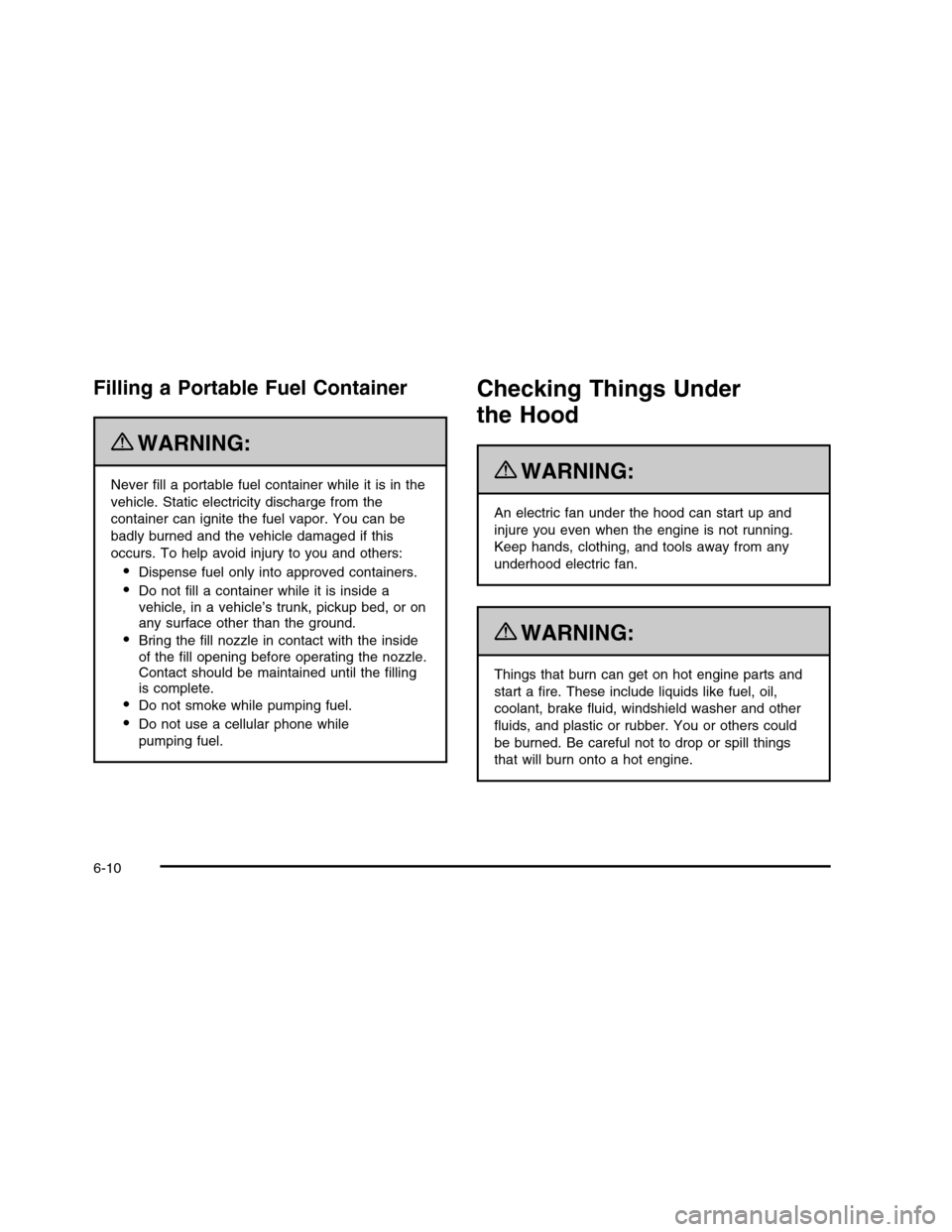hood open CADILLAC DTS 2010 1.G Owners Manual
[x] Cancel search | Manufacturer: CADILLAC, Model Year: 2010, Model line: DTS, Model: CADILLAC DTS 2010 1.GPages: 480, PDF Size: 17.56 MB
Page 134 of 480

Engine Coolant Heater
The engine coolant heater can provide easier startingand better fuel economy during engine warm-up in coldweather conditions at or below 0°F (!18°C). Vehicleswith an engine coolant heater should be pluggedin at least four hours before starting.
To Use the Engine Coolant Heater
1. Turn off the engine.
2. Open the hood and unwrap the electrical cord.
The electrical cord is located on the driver sideof the engine, behind the transmission dipstick/fluidfill location and next to the engine.
3. Plug it into a normal, grounded 110-volt AC outlet.
{WARNING:
Plugging the cord into an ungrounded outlet could
cause an electrical shock. Also, the wrong kind of
extension cord could overheat and cause a fire.
You could be seriously injured. Plug the cord into
a properly grounded three-prong 110-volt AC
outlet. If the cord will not reach, use a heavy-duty
three-prong extension cord rated for at least
15 amps.
4. Before starting the engine, be sure to unplug andstore the cord as it was before to keep it awayfrom moving engine parts and prevent damage.
The length of time the heater should remain plugged independs on several factors. Ask a dealer/retailer inthe area where you will be parking the vehicle for thebest advice on this.
3-26
Page 207 of 480

There is also an interiortemperature sensorlocated next to the steeringwheel that measures thetemperature of the airinside the vehicle.
There is also an exterior temperature sensor locatedbehind the front grille. This sensor reads the outside airtemperature and helps maintain the temperatureinside the vehicle. Any cover on the front of the vehiclecould cause a false reading in the displayedtemperature.
In order to prevent false temperature readings atstartup, the displayed temperature will not change untilthe following occurs:
•Vehicle speed is above 16 km/h (10 mph) for
5 minutes.
•Vehicle speed is above 51 km/h (32 mph) for 2 and
a half minutes.
The climate control system uses the information fromthese sensors to maintain your comfort setting byadjusting the outlet temperature, fan speed, and the airdelivery mode. The system may also supply coolerair to the side of the vehicle facing the sun. Therecirculation mode will also be used as needed tomaintain cool outlet temperatures.
Outlet Adjustment
For the front outlets, use the thumbwheel located beloweach outlet to change the direction of the airflow. Use thethumbwheel located next to the outlets to shut the airflowor to open the outlets and re-direct the air.
For the rear outlets, slide the lever left or right and up ordown to change the direction of the airflow.
Operation Tips
•Clear away any ice, snow or leaves from the air
inlets at the base of the windshield that mayblock the flow of air into your vehicle.
•Use of non-GM approved hood deflectors may
adversely affect the performance of the system.
•Keep the path under the front seats clear of objects
to help circulate the air inside of your vehicle moreeffectively.
4-41
Page 237 of 480

FOLLOWING GAP
This symbol appears with this message.
If your vehicle has Adaptive Cruise Control (ACC), thismessage displays to show the follow distance thathas been set. There are six follow distances to choosefrom. Each follow distance is shown on the DIC bydisplaying from one to six bars between two carsymbols. SeeAdaptive Cruise Control on page 4-15formore information.
FUEL LEVEL LOW
This symbol appears withthis message.
This message displays when your vehicle is low on fuel.Refill the fuel tank as soon as possible. A singlechime sounds when this message is displayed. SeeFilling the Tank on page 6-8.
HOOD OPEN
This symbol appears withthis message.
This message displays when the hood is not closedcompletely. Make sure that the hood is closedcompletely. SeeHood Release on page 6-11.
ICE POSSIBLE DRIVE WITH CARE
This message displays when the outside temperature iscold enough to create icy road conditions. Adjustyour driving accordingly.
4-71
Page 326 of 480

If this occurs, use a gasoline rated at 87 octane orhigher as soon as possible. Otherwise, you coulddamage the engine. If heavy knocking is heard whenusing gasoline rated at 87 octane or higher, the engineneeds service.
Gasoline Specifications
At a minimum, gasoline should meet ASTM specificationD 4814 in the United States or CAN/CGSB-3.5 or3.511 in Canada. Some gasolines contain anoctane-enhancing additive called methylcyclopentadienylmanganese tricarbonyl (MMT). We recommendagainst the use of gasolines containing MMT. SeeAdditives on page 6-6for additional information.
California Fuel
If the vehicle is certified to meet California EmissionsStandards, it is designed to operate on fuels thatmeet California specifications. See the underhoodemission control label. If this fuel is not availablein states adopting California emissions standards, thevehicle will operate satisfactorily on fuels meeting federalspecifications, but emission control system performancemight be affected. The malfunction indicator lampcould turn on and the vehicle might fail asmog-check test.
SeeMalfunction Indicator Lamp on page 4-57. If thisoccurs, return to your authorized dealer/retailer fordiagnosis. If it is determined that the condition is causedby the type of fuel used, repairs might not be coveredby the vehicle warranty.
Additives
To provide cleaner air, all gasolines in the United Statesare now required to contain additives that help preventengine and fuel system deposits from forming, allowingthe emission control system to work properly. In mostcases, nothing should have to be added to the fuel.However, some gasolines contain only the minimumamount of additive required to meet U.S. EnvironmentalProtection Agency regulations. To help keep fuel injectorsand intake valves clean, or if the vehicle experiencesproblems due to dirty injectors or valves, look for gasolinethat is advertised as TOP TIER Detergent Gasoline.
For customers who do not use TOP TIER DetergentGasoline regularly, one bottle of GM Fuel SystemTreatment PLUS, added to the fuel tank at everyengine oil change, can help clean deposits from fuelinjectors and intake valves. GM Fuel System TreatmentPLUS is the only gasoline additive recommended byGeneral Motors.
Also, your dealer/retailer has additives that will helpcorrect and prevent most deposit-related problems.
6-6
Page 330 of 480

Filling a Portable Fuel Container
{WARNING:
Never fill a portable fuel container while it is in the
vehicle. Static electricity discharge from the
container can ignite the fuel vapor. You can be
badly burned and the vehicle damaged if this
occurs. To help avoid injury to you and others:
•Dispense fuel only into approved containers.
•Do not fill a container while it is inside a
vehicle, in a vehicle’s trunk, pickup bed, or onany surface other than the ground.
•Bring the fill nozzle in contact with the inside
of the fill opening before operating the nozzle.Contact should be maintained until the fillingis complete.
•Do not smoke while pumping fuel.
•Do not use a cellular phone while
pumping fuel.
Checking Things Under
the Hood
{WARNING:
An electric fan under the hood can start up and
injure you even when the engine is not running.
Keep hands, clothing, and tools away from any
underhood electric fan.
{WARNING:
Things that burn can get on hot engine parts and
start a fire. These include liquids like fuel, oil,
coolant, brake fluid, windshield washer and other
fluids, and plastic or rubber. You or others could
be burned. Be careful not to drop or spill things
that will burn onto a hot engine.
6-10
Page 332 of 480

Engine Compartment Overview
When you open the hood, here is what you will see:
4.6L L37 Engine shown, 4.6L LD8 Engine similar
6-12
Page 348 of 480

You may decide not to lift the hood when this warningappears, but instead get service help right away.SeeRoadside Service on page 8-7.
If you do decide to lift the hood, make sure the vehicleis parked on a level surface.
Then check to see if the engine cooling fans arerunning. If the engine is overheating, both fans shouldbe running. If they are not, do not continue to runthe engine and have the vehicle serviced.
Notice:Engine damage from running the enginewithout coolant is not covered by the warranty.
Notice:If the engine catches fire while driving withno coolant, the vehicle can be badly damaged.The costly repairs would not be covered bythe vehicle warranty. SeeOverheated EngineProtection Operating Mode on page 6-29forinformation on driving to a safe place in anemergency.
If Steam Is Coming From The Engine
Compartment
{WARNING:
Steam from an overheated engine can burn you
badly, even if you just open the hood. Stay away
from the engine if you see or hear steam coming
from it. Turn it off and get everyone away from the
vehicle until it cools down. Wait until there is no sign
of steam or coolant before you open the hood.
If you keep driving when the vehicles engine is
overheated, the liquids in it can catch fire. You or
others could be badly burned. Stop the engine if it
overheats, and get out of the vehicle until the
engine is cool.
SeeOverheated Engine Protection Operating Mode
on page 6-29for information on driving to a safe
place in an emergency.
6-28
Page 357 of 480

2. Get the vehicles close enough so the jumper cablescan reach, but be sure the vehicles are not touchingeach other. If they are, it could cause a groundconnection you do not want. You would not be ableto start your vehicle and the bad grounding coulddamage the electrical systems.
To avoid the possibility of the vehicles rolling, setthe parking brake firmly on both vehicles involved inthe jump start procedure. Put an automatictransmission in P (Park) or a manual transmissionin NEUTRAL before setting the parking brake.
Notice:If you leave the radio or other accessorieson during the jump starting procedure, they could bedamaged. The repairs would not be covered by thewarranty. Always turn off the radio and otheraccessories when jump starting the vehicle.
3. Turn off the ignition on both vehicles. Unplugunnecessary accessories plugged into the cigarettelighter or the accessory power outlets. Turn offthe radio and all lamps that are not needed. Thiswill avoid sparks and help save both batteries.And it could save the radio!
4. Open the hoods and locate the positive (+) andnegative (!) terminal locations on the othervehicle. Your vehicle has a remote positive (+) jumpstarting terminal and a remote negative (!) jumpstarting terminal.
The remote positive (+) terminal is located in theengine compartment on the passenger’s side of thevehicle. Lift the red plastic cap to access theterminal. SeeEngine Compartment Overview onpage 6-12for more information on the locationof the remote positive (+) terminal.
A second remote positive (+) terminal is located onthe rear underseat fuse block.
The remote negative (!) terminal is located behindthe power steering pulley, near the engine cover.It is marked GND (!).
4.6L LD8 Engine shown,4.6L L37 Enginesimilar
6-37
Page 361 of 480

It is recommended that the vehicle is taken to yourdealer/retailer for service if the headlamps need to bere-aimed. It is possible however, to re-aim theheadlamps as described.
Notice:To make sure the headlamps are aimedproperly, read all the instructions before beginning.Failure to follow these instructions could causedamage to headlamp parts.
The vehicle should:
•Be placed so the headlamps are 25 ft. (7.6 m) from
a light colored wall.
•Have all four tires on a level surface which is level
all the way to the wall.
•Be placed so it is perpendicular to the wall.
•Not have any snow, ice, or mud on it.
•Be fully assembled and all other work stopped while
headlamp aiming is being performed.
•Be normally loaded with a full tank of fuel and one
person or 160 lbs (75 kg) sitting on the driver seat.
•Have all tires properly inflated.
•Have the spare tire is in its original location in the
vehicle.
Headlamp aiming is done with the vehicle’s low-beamheadlamps. The high-beam headlamps will be correctlyaimed if the low-beam headlamps are aimed properly.
To adjust the vertical aim:
1. Open the hood. SeeHood Release on page 6-11for more information.
2. Find the center line running through the lens of theheadlamp.
3. Record the distance from the ground to the centerline running through the lens of the headlamp.
6-41
Page 421 of 480

Power Windows and Other Power
Options
Circuit breakers in the fuse block protect the powerwindows and other power accessories. When the currentload is too heavy, the circuit breaker opens andcloses, protecting the circuit until the problem is fixed orgoes away.
Fuses and Circuit Breakers
The wiring circuits in the vehicle are protected fromshort circuits by a combination of fuses and circuitbreakers. This greatly reduces the chance of firescaused by electrical problems.
Look at the silver-colored band inside the fuse. If theband is broken or melted, replace the fuse. Be sure youreplace a bad fuse with a new one of the identicalsize and rating.
If you ever have a problem on the road and don’t havea spare fuse, you can borrow one that has the sameamperage. Just pick some feature of the vehicle that youcan get along without — like the radio or cigarettelighter — and use its fuse, if it is the correct amperage.Replace it as soon as you can.
Underhood Fuse Block
The underhood fuse block is located on the passengerside of the engine compartment. Remove the fusecover and secondary service cover to access thefuse block.
Notice:Spilling liquid on any electrical componentson the vehicle may damage it. Always keep thecovers on any electrical component.
6-101